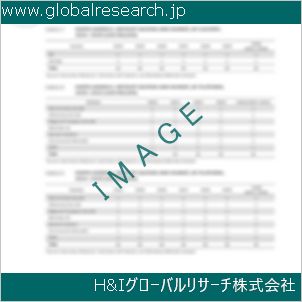Table of Contents
1 Industry Overview of Periodicacid
1.1 Definition and Specifications of Periodicacid
1.1.1 Definition of Periodicacid
1.1.2 Specifications of Periodicacid
1.2 Classification of Periodicacid
1.3 Applications of Periodicacid
1.3.1 Nuclear Application
1.3.2 Non-Nuclear Application
1.4 Industry Chain Structure of Periodicacid
1.5 Industry Overview and Major Regions Status of Periodicacid
1.5.1 Industry Overview of Periodicacid
1.5.2 Global Major Regions Status of Periodicacid
1.6 Industry Policy Analysis of Periodicacid
1.7 Industry News Analysis of Periodicacid
2 Manufacturing Cost Structure Analysis of Periodicacid
2.1 Raw Material Suppliers and Price Analysis of Periodicacid
2.2 Equipment Suppliers and Price Analysis of Periodicacid
2.3 Labor Cost Analysis of Periodicacid
2.4 Other Costs Analysis of Periodicacid
2.5 Manufacturing Cost Structure Analysis of Periodicacid
2.6 Manufacturing Process Analysis of Periodicacid
3 Technical Data and Manufacturing Plants Analysis of Periodicacid
3.1 Capacity and Commercial Production Date of Global Periodicacid Major Manufacturers in 2023
3.2 Manufacturing Plants Distribution of Global Periodicacid Major Manufacturers in 2023
3.3 R&D Status and Technology Source of Global Periodicacid Major Manufacturers in 2023
3.4 Raw Materials Sources Analysis of Global Periodicacid Major Manufacturers in 2023
4 Capacity, Production and Revenue Analysis of Periodicacid by Regions, Types and Manufacturers
4.1 Global Capacity, Production and Revenue of Periodicacid by Regions 2019-2024
4.2 Global and Major Regions Capacity, Production, Revenue and Growth Rate of Periodicacid 2019-2024
4.3 Global Capacity, Production and Revenue of Periodicacid by Types 2019-2024
4.4 Global Capacity, Production and Revenue of Periodicacid by Manufacturers 2019-2024
5 Price, Cost, Gross and Gross Margin Analysis of Periodicacid by Regions, Types and Manufacturers
5.1 Price, Cost, Gross and Gross Margin Analysis of Periodicacid by Regions 2019-2024
5.2 Price, Cost, Gross and Gross Margin Analysis of Periodicacid by Types 2019-2024
5.3 Price, Cost, Gross and Gross Margin Analysis of Periodicacid by Manufacturers 2019-2024
6 Consumption Volume, Consumption Value and Sale Price Analysis of Periodicacid by Regions, Types and Applications
6.1 Global Consumption Volume and Consumption Value of Periodicacid by Regions 2019-2024
6.2 Global and Major Regions Consumption Volume, Consumption Value and Growth Rate of Periodicacid 2019-2024
6.3 Global Consumption Volume and Consumption Value of Periodicacid by Types 2019-2024
6.4 Global Consumption Volume and Consumption Value of Periodicacid by Applications 2019-2024
6.5 Sale Price of Periodicacid by Regions 2019-2024
6.6 Sale Price of Periodicacid by Types 2019-2024
6.7 Sale Price of Periodicacid by Applications 2019-2024
6.8 Market Share Analysis of Periodicacid by Different Sale Price Levels
7 Supply, Import, Export and Consumption Analysis of Periodicacid
7.1 Supply, Consumption and Gap of Periodicacid 2019-2024
7.2 Global Capacity, Production, Price, Cost, Revenue, Supply, Import, Export and Consumption of Periodicacid 2019-2024
7.3 USA Capacity, Production, Price, Cost, Revenue, Supply, Import, Export and Consumption of Periodicacid 2019-2024
7.4 EU Capacity, Production, Price, Cost, Revenue, Supply, Import, Export and Consumption of Periodicacid 2019-2024
7.5 China Capacity, Production, Price, Cost, Revenue, Supply, Import, Export and Consumption of Periodicacid 2019-2024
7.6 Japan Capacity, Production, Price, Cost, Revenue, Supply, Import, Export and Consumption of Periodicacid 2019-2024
8 Major Manufacturers Analysis of Periodicacid
8.1 Manufacturer One
8.1.1 Company Profile
8.1.2 Product Picture and Specifications
8.1.2.1 Type I
8.1.2.2 Type II
8.1.2.3 Type III
8.1.3 Capacity, Production, Price, Cost, Gross and Revenue
8.1.4 Contact Information
8.2 Manufacturer Two
8.2.1 Company Profile
8.2.2 Product Picture and Specifications
8.2.2.1 Type I
8.2.2.2 Type II
8.2.2.3 Type III
8.2.3 Capacity, Production, Price, Cost, Gross and Revenue
8.2.4 Contact Information
8.3 Manufacturer Three
8.3.1 Company Profile
8.3.2 Product Picture and Specifications
8.3.2.1 Type I
8.3.2.2 Type II
8.3.2.3 Type III
8.3.3 Capacity, Production, Price, Cost, Gross and Revenue
8.3.4 Contact Information
8.4 Manufacturer Four
8.4.1 Company Profile
8.4.2 Product Picture and Specifications
8.4.2.1 Type I
8.4.2.2 Type II
8.4.2.3 Type III
8.4.3 Capacity, Production, Price, Cost, Gross and Revenue
8.4.4 Contact Information
8.5 Manufacturer Five
8.5.1 Company Profile
8.5.2 Product Picture and Specifications
8.5.2.1 Type I
8.5.2.2 Type II
8.5.2.3 Type III
8.5.3 Capacity, Production, Price, Cost, Gross and Revenue
8.5.4 Contact Information
…
9 Marketing Trader or Distributor Analysis of Periodicacid
9.1 Marketing Channels Status of Periodicacid
9.2 Traders or Distributors with Contact Information of Periodicacid by Regions
9.3 Ex-work Price, Channel Price and End Buyer Price Analysis of Periodicacid
9.4 Regional Import, Export and Trade Analysis of Periodicacid
10 Industry Chain Analysis of Periodicacid
10.1 Upstream Major Raw Materials Suppliers Analysis of Periodicacid
10.1.1 Major Raw Materials Suppliers with Contact Information Analysis of Periodicacid
10.1.2 Major Raw Materials Suppliers with Supply Volume Analysis of Periodicacid by Regions
10.2 Upstream Major Equipment Suppliers Analysis of Periodicacid
10.2.1 Major Equipment Suppliers with Contact Information Analysis of Periodicacid
10.2.2 Major Equipment Suppliers with Product Pictures Analysis of Periodicacid by Regions
10.3 Downstream Major Consumers Analysis of Periodicacid
10.3.1 Major Consumers with Contact Information Analysis of Periodicacid
10.3.2 Major Consumers with Consumption Volume Analysis of Periodicacid by Regions
10.4 Supply Chain Relationship Analysis of Periodicacid
11 Development Trend of Analysis of Periodicacid
11.1 Capacity, Production and Revenue Forecast of Periodicacid by Regions and Types
11.1.1 Global Capacity, Production and Revenue of Periodicacid by Regions 2024-2029
11.1.2 Global and Major Regions Capacity, Production, Revenue and Growth Rate of Periodicacid 2024-2029
11.1.3 Global Capacity, Production and Revenue of Periodicacid by Types 2024-2029
11.2 Consumption Volume and Consumption Value Forecast of Periodicacid by Regions, Types and Applications
11.2.1 Global Consumption Volume and Consumption Value of Periodicacid by Regions 2024-2029
11.2.2 Global and Major Regions Consumption Volume, Consumption Value and Growth Rate of Periodicacid 2024-2029
11.2.3 Global Consumption Volume and Consumption Value of Periodicacid by Types 2024-2029
11.2.4 Global Consumption Volume and Consumption Value of Periodicacid by Applications 2024-2029
11.3 Supply, Import, Export and Consumption Forecast of Periodicacid
11.3.1 Supply, Consumption and Gap of Periodicacid 2024-2029
11.3.2 Global Capacity, Production, Price, Cost, Revenue, Supply, Import, Export and Consumption of Periodicacid 2024-2029
11.3.3 USA Capacity, Production, Price, Cost, Revenue, Supply, Import, Export and Consumption of Periodicacid 2024-2029
11.3.4 EU Capacity, Production, Price, Cost, Revenue, Supply, Import, Export and Consumption of Periodicacid 2024-2029
11.3.5 China Capacity, Production, Price, Cost, Revenue, Supply, Import, Export and Consumption of Periodicacid 2024-2029
11.3.6 Japan Capacity, Production, Price, Cost, Revenue, Supply, Import, Export and Consumption of Periodicacid 2024-2029
12 New Project Investment Feasibility Analysis of Periodicacid
12.1 New Project SWOT Analysis of Periodicacid
12.2 New Project Investment Feasibility Analysis of Periodicacid
13 Conclusion of the Global Periodicacid (CAS 13444-71-8) Industry 2024 Market Research Report
| ※参考情報 過ヨウ素酸(Periodic acid)は、化学式 HIO4 または H5IO6 で表される酸で、主に有機合成や生化学の分野で重要な役割を果たしています。CAS番号は 13444-71-8 です。この物質は、ヨウ素を含む酸の一種であり、化学的な特性や異性体の存在から、多様な用途があります。 過ヨウ素酸は、通常、無色または淡い黄色の結晶または粉末として存在します。水に溶解しやすく、酸性の環境で安定しています。また、過ヨウ素酸の特徴として、酸化剤としての能力が挙げられます。特に、有機化合物中の二重結合やヒドロキシル基に対して酸化反応を引き起こすことができます。この性質が、過ヨウ素酸の主要な利用方法の一つです。 過ヨウ素酸には、主に二つの異性体が存在します。第一異性体は、通常の過ヨウ素酸であり、第二異性体は、過ヨウ素酸の加水分解によって生成される異性体です。ただし、これらの異性体の性質や反応性は異なるため、特定の用途に応じた選択が求められます。 用途としては、特に有機合成において重要です。過ヨウ素酸は、糖類や多価アルコールの酸化反応に利用されます。特に、グルコースやフルクトースなどの糖の構造解析において、それらを酸化して二官能性化合物を生成する際に便利です。これにより、これらの化合物の詳しい化学的特性や反応を調査することが可能になります。 また、過ヨウ素酸は、生化学の分野でも利用が広がっています。特に、糖質や核酸に対する反応が注目されています。例えば、DNAやRNAの複製において、過ヨウ素酸を用いることで、特定の糖鎖結合を選択的に攻撃し、構造的な変化を引き起こすことができます。これにより、厳密な生化学的研究や診断技術の開発が進んでいます。 過ヨウ素酸は、他の化合物との反応も多様で、例えばアルコールとの反応においては、アルデヒドやケトンを生成します。このような反応は、特に有機合成において新たな化合物を合成する手法として利用されます。そのため、化学者や研究者にとって有用な試薬とされています。 さらに、過ヨウ素酸の関連技術としては、反応条件の最適化や新しい合成法の開発が挙げられます。これには、触媒を使用した反応の促進や、反応条件の変更によって得られる生成物の特性を制御する研究が含まれます。特に、持続可能な化学プロセスの開発が重要視されており、過ヨウ素酸を用いた反応がその一助となることが期待されています。 過ヨウ素酸の取扱いには注意が必要です。その強力な酸化性により、皮膚や眼に刺激を与える可能性があり、取り扱い時には適切な保護具の着用が推奨されます。また、体内に取り込まれると毒性があるため、取り扱いには厳重な注意が欠かせません。このような特性から、過ヨウ素酸を安全に扱うための技術やガイドラインが求められています。 近年、過ヨウ素酸の新たな用途やその利用方法についての研究が盛んに行われています。例えば、ナノテクノロジー分野では、材料の表面改質や機能化に関する研究が進行中であり、過ヨウ素酸の酸化特性が利用されています。また、環境化学の分野でも、過ヨウ素酸を用いた汚染物質の分解や無害化プロセスの開発が進められています。 総じて言えることは、過ヨウ素酸はその特性や多様な反応性により、化学、生命科学、環境科学など、幅広い分野で重要な役割を果たし続けているということです。これからも、その利用技術や応用研究が進展し、新たな発見や解決策が期待されています。安全に利用しつつ、その多様性を最大限に引き出す努力が必要です。 |
❖ 免責事項 ❖
http://www.globalresearch.jp/disclaimer












